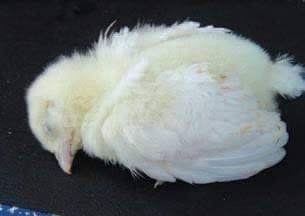 GET THIS NOW: AUTOMATED INCOME MACHINE
GET THIS NOW: AUTOMATED INCOME MACHINE
How to diagnose poultry diseases based on symptoms and general behavior
Birds that are very sick usually look very drowsy, with their eyes half closed, their wings droop, have rough feathers, and seem to move only with great effort. They may huddle on the roost or floor.
1. Neck twisting and paralysis:
A bird that twists its neck could be suffering from Newcastle Disease, Fowl Cholera, a brain infection, or an improper injection of Marek’s Disease and Botulism. If the neck is retracted over the back, it is likely a sign of a nutritional (vitamin) deficiency or possibly Newcastle Disease once again.
 Learn More
Learn More
2. Loss of weight, shape, and size:
In diseases that cause a rapid decline in health, birds exhibit a dejected appearance with dull eyes and blank expressions. The loss of weight, shape, and size can be attributed to a lack of feeding, nutritional deficiencies, lymphoid leucosis, gizzard impaction, and worm infestations.
Stunted and uneven growth can still result from gizzard impaction, overcrowding, inadequate feeding, blue comb disease, aflatoxin poisoning, and joint inflammation.
3. Feather condition (feather pecking, feather eating, and feather picking) :
Feather pecking, eating, and picking may be caused by, amongst other factors, a deficiency in nutrition (methionine). This could also suggest that the birds have not been de-beaked. The loss of feathers could be a sign of molting.
Additionally, infectious coryza can cause feathers to become moist under the wings, while deposits at the feather shafts’ base may indicate the presence of lice and mite eggs.
4. Nasal discharges:
Nasal Discharges are a common symptom in infectious coryza, chronic respiratory disease, infectious bronchitis, and avian influenza (bird flu).
5. The skin:
The symptoms associated with skin conditions include excessive pigmentation, as seen in cases of poorly productive birds, and nodules, mainly on the legs, as in the case of Marek’s disease.
6. Swollen faces:
Swollen faces are commonly seen in the following conditions: infectious coryza, Newcastle disease, vitamin A deficiency, colibacillosis (where the face appears darkened and purplish), and injuries. Nodules on the face may be caused by fowl pox.
Invest in this knowledge-packed ebook promptly.  39 fundamentals for poultry broiler production management
39 fundamentals for poultry broiler production management
7. The eyes:
There are several eye conditions that can affect poultry. Watery eyes are often a sign of infection known as coryza. Blindness can be caused by either fowl pox or aspergillosis. Irregular pupils can indicate Marek’s disease. If the eyes appear watery, red, inflamed, and frequently closed, it could be a result of New Castle’s disease, vitamin A deficiency, ammonia burns, or infectious laryngotracheitis.

Crusty eyelids may also indicate a vitamin A deficiency. Enlarged and swollen eyes are often a symptom of mycoplasma infection.
READ ALSO How to Prevent Decline in Egg Quality Late Egg Production
8. Leg abnormalities:
Leg abnormalities can be observed in various conditions, including Marek’s disease, heatstroke, cage layer fatigue, vitamin deficiency, and acute water shortage, which can result in leg paralysis. Fowl pox causes rough and scaly legs, while scaly leg mite infestation leads to scaly legs.
Vitamin D deficiency results in bow legs, and swollen joints and can be caused by infections in joints, Pullorum disease, staphylococcal infection, and joint inflammation.
9. Swollen and bulbous wattles:
Swollen and Bulbous Wattles, Infection Coryza, and Fowl Cholera.
10. Nodes on wattles and combs:
Fowl pox
11. The mouth:
Pustules in the mouth -Vitamin A deficiency
Crusts at the margins -Nutritional deficiency of biotin or pantothenic acid
Soft and rubbery beak -Imbalance of calcium and phosphorus
White coating over the tongue -Wet form of fowl pox
Ulcers in the mouth -Mycotoxin infection
-Chemical injury
Purchase this compelling ebook instantly. 
 33 fundamentals for poultry layer production management
33 fundamentals for poultry layer production management
12. Death:
In many instances, the manner in which death occurs can indicate specific disease conditions. Immediate death with little to no warning signs can be caused by Fowl cholera, acute dehydration, and overheating.
A high death rate can be caused by a variety of factors including Fowl cholera, Newcastle disease, acute coccidiosis, Aflatoxicosis, and Botulism, among others.
READ ALSO Why Chickens Laying Thin-shell Eggs (Management factors) and How to Prevent?
It is important to pay attention to the way in which death occurs in order to determine the underlying cause and take the necessary steps to prevent the further spread of the disease.
ATTENTION: Click “HERE” to join our WhatsApp group and receive More updates directly on your WhatsApp!
13. Egg production:
In addition to death, a decrease in egg production can also indicate certain disease conditions in poultry. Understanding the symptoms and signs of low egg production can help diagnose and prevent future outbreaks.
A sudden drop in egg production can be caused by various reasons such as Newcastle disease, Infectious bronchitis, Infectious Laryngotracheitis, Avian influenza, mismanagement, fowl cholera, chronic respiratory disease, dietary deficiencies, gizzard impaction, fowl pox, lice, mites, and worms, and lymphoid leucosis.
Lowered egg production can be a result of diseases such as Coccidiosis, Enteritis, and Aflatoxicosis.
Abnormalities in egg shape and pigmentation can also indicate health issues such as Necrotic enteritis, Infectious bronchitis, Newcastle disease, dietary deficiency, Vitamin D deficiency, and Calcium and phosphorus deficiency.
Regular monitoring and prompt treatment of any issues can help maintain a healthy flock and consistent egg production.
14. Check Droppings:
Always take note of the appearance of droppings. If they are abundant, it could indicate an issue with intestinal health (such as enteritis) or a diet high in roughage.
If you observe blood in the droppings, one of the possible causes could be caecal, coccidiosis, or, to a lesser extent, Newcastle disease.
If feed intake is low, you may also notice green droppings. Sulfur-yellow droppings are common in birds with blackheads, while light yellow or yellowish-green droppings are a common symptom of fowl cholera.
Intestinal parasite (protozoa) infestation typically results in foamy droppings.
15. Look at the feet of birds:
If the joints are stiff and the birds struggle to bend their legs, it is a sign of a problem with the tendons that hold the joints together. This condition is known as tenosynovitis.
The bird may also walk on its toes, and if the bottom of its feet is swollen, it may have a staphylococcus infection known as bumble foot.
When the toes are curled, the most common cause is a deficiency in riboflavin (vitamin B2), however, it could also be a result of genetics or poor management.















